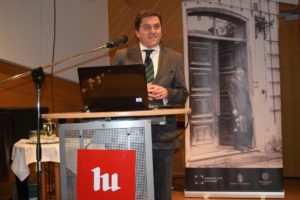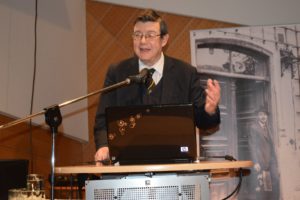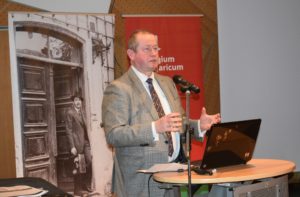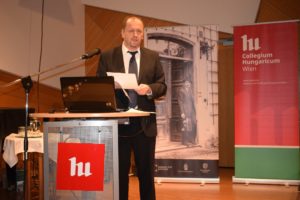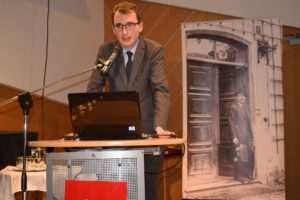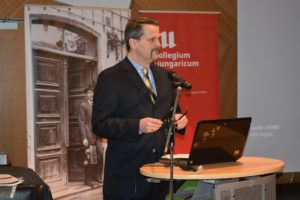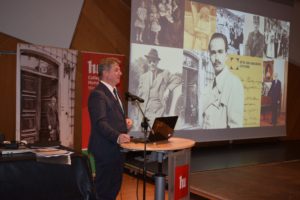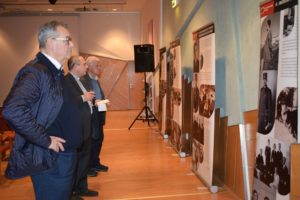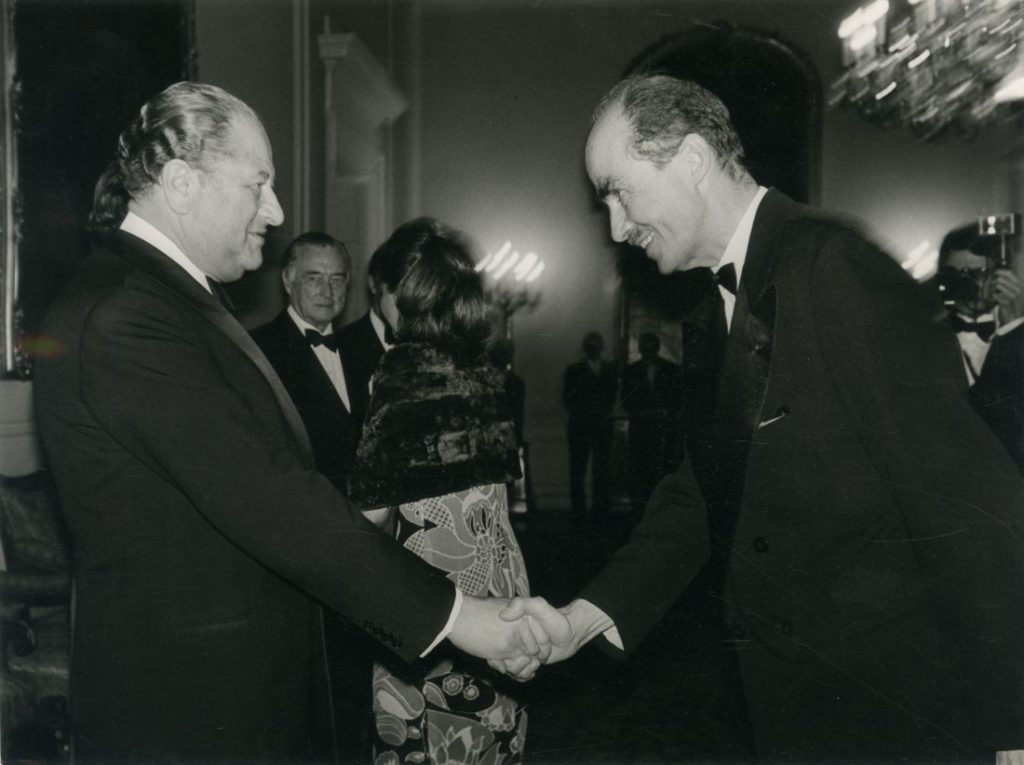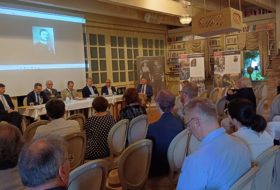The Otto von Habsburg Foundation and the Collegium Hungaricum in Vienna recalled some important moments of Otto von Habsburg’s exceptional career with a conference and exhibition on 24 January 2023, paying special attention to the role of the former heir to the throne in the political transformations of Central Europe. At the same time, the speakers of the event highlighted some of the points of inspiration of Otto von Habsburg’s intellectual legacy that may be relevant for public action not only in the past decades, but also today.
In his opening speech, Iván Bertényi, Deputy Director of the Collegium Hungaricum and Head of the Hungarian Historical Institute in Vienna, emphasized that Otto von Habsburg paid special attention to the successor states of the Danubian Monarchy, which were forced to the eastern side of the Iron Curtain by the Yalta decision. Throughout his political career, he has consistently advocated the right of self-determination for the nations of Central Europe and has done much to promote their European integration. These efforts and his work for a united Europe are a key part of his political legacy.
In his introductory speech, Rainhard Kloucek, member of the Austrian Presidency of the Pan-European Union, stressed that for the Pan-European Union, the dismantling of the Iron Curtain was a clearly defined goal, as the movement saw a united Europe first and foremost as a security community that should be open to all European people, to all European nations. This struggle was given a new impetus by Otto von Habsburg, who was elected first Vice-President and then President in 1973, and who was one of the first to realise that the communist regime, and thus the bipolar world order, could not last.In addition to stressing the importance of real political engagement and the Pan-European Picnic, which is the most important element of this, the Secretary General underlined that the Movement has been from the very beginning a mediator of the idea of a united Europe in the wider region, based on common values and inspired by the principle of subsidiarity, which is also enshrined in the European treaties. At the end of his presentation, the Secretary General stressed that the experience of the period of regime change and the political legacy of Otto von Habsburg can still provide useful lessons for policy makers.
The lecture of Róbert Fiziker, Chief Archivist of the National Archives of Hungary, examined the relationship between Otto von Habsburg, who left Hungary in the autumn of 1918 as heir to the throne and returned as a Member of the European Parliament in the summer of 1987, and the Hungarian nation. He demonstrated that the politician, who had always shown solidarity with the country, represented Hungarian (and Central European) interests all over the world in fluent Hungarian, whether as the nation’s representative in the United States during World War II, during the Cold War, and then during the period of regime change and Euro-Atlantic accession. The lecture highlighted other important points of Otto von Habsburg’s public engagement in Hungary, and how his work for the country fitted into the statesman’s more far-reaching political vision. He stressed that centuries of living with the Habsburgs had created a particular national memory, one that was rather narrow-minded and dismissive of the members of the previous ruling dynasty, but that Otto von Habsburg was certainly an exception to this: his political credo was always characterised by work for the common good, and this public attitude brought him popularity.
Joining Róbert Fiziker’s presentation, Bence Kocsev, colleague of the Otto von Habsburg Foundation explained that the last Hungarian heir to the throne was able to convert lost power into political and social capital, which then elevated him to one of the most important public figures of the 20th century, thanks to his exceptional sense of mission and work ethic. As the other lectures highlighted, one of the most important elements of his life’s work was his work for the unification of the European continent. Otto von Habsburg, however, did not conceive of European integration as a kind of integration based on legal rules, but stressed the importance of the common intellectual foundations without which the unification of the continent would be unthinkable. Referring back to Rainhard Kloucek’s lecture, Bence Kocsev also pointed out that Otto von Habsburg was actively involved in preparing the regime changes in the wider region (including the Baltic States and Germany) and later supported their accession to the Euro-Atlantic area. His exceptional charisma was the result of his historical awareness and the political insight that often flowed from it, on the one hand, and a disposition that struck a balance between his natural optimism and the sense of reality that deeply informed his decisions, on the other.
Helmut Wohnout, Director-General of the Austrian State Archives, began his presentation by showing a photograph of the iconic 1972 handshake between Austrian Chancellor Bruno Kreisky and Otto von Habsburg. He mentioned that during his visit to Budapest last summer, he gave a copy of the photo taken at the celebration of the 50th anniversary of the Pan-European Union to our Foundation. The gesture shown in the photograph was a symbolic expression of the fact that the political leadership of the Republic of Austria, after five decades and at the end of a turbulent period, had reached a special reconciliation with the head of the Habsburg family, who had also been an Austrian citizen since 1961. But the reconciliation was preceded by a long public debate. The Director-General described how Chancellor Kreisky had sought to resolve the political (and to some extent social) tensions that had arisen over the return of Otto von Habsburg and how he had finally successfully managed the state affair known as the “Causa Habsburg”, which had long been a source of coalition tensions. The fact that he was kept away from Austria for so long did far more harm to the country than to Otto von Habsburg himself. At the end of his lecture, Helmut Wohnout spoke of the political acumen of the former Crown Prince and the necessity of looking after the legacy kept at our Foundation, as well as the importance of processing this collection and the intellectual heritage.
Iconic handshake between Austrian Chancellor Bruno Kreisky and Otto von Habsburg (1972)
Lothar Höbelt, Professor Emeritus of modern history at the University of Vienna, gave a lecture entitled “Otto von Habsburg as an exceptional political personality”, which presented the unique public activities of the former Crown Prince. The lecture revealed the life of a statesman who was able to transform his historical knowledge and versatility into a kind of practical knowledge, and whose dynastic experience and family heritage were transformed into a political programme that would make him a major Christian Democrat and conservative politician of the 20th century.
The conference ended with a presentation by Gergely Prőhle, Director of the Otto von Habsburg Foundation. He presented the processing work carried out so far on the material and intellectual heritage of our namesake and the longer-term objectives of the Foundation. He pointed out that on the day before the event in Vienna, our Foundation presented its collection to the public and launched its online platform, which will make the legacy of the last Hungarian heir to the throne easily accessible to the Hungarian and international public through the gradual digitisation of the collection. Gergely Prőhle stressed that the processing of material heritage and the care of the intellectual values left behind by Otto von Habsburg are mutually intertwined, since the latter can only be done on the basis of archival work supported by scientific accuracy and philological precision. And this work is in line with internationally accepted practice and that of national institutions. He said that last year’s double jubilee – the 110th anniversary of the birth of Otto von Habsburg and the 100th anniversary of the death of Charles IV – had significantly increased the Foundation’s international visibility, in addition to its active domestic presence. The Director has also set the ambition of building an international academic and public network that, by becoming an intellectual centre, can serve as a meeting point for researchers of the political and intellectual history of the second half of the 20th century.
The event also featured an exhibition on the life of Otto von Habsburg, compiled by our Foundation.
Photos: Collegium Hungaricum Wien

